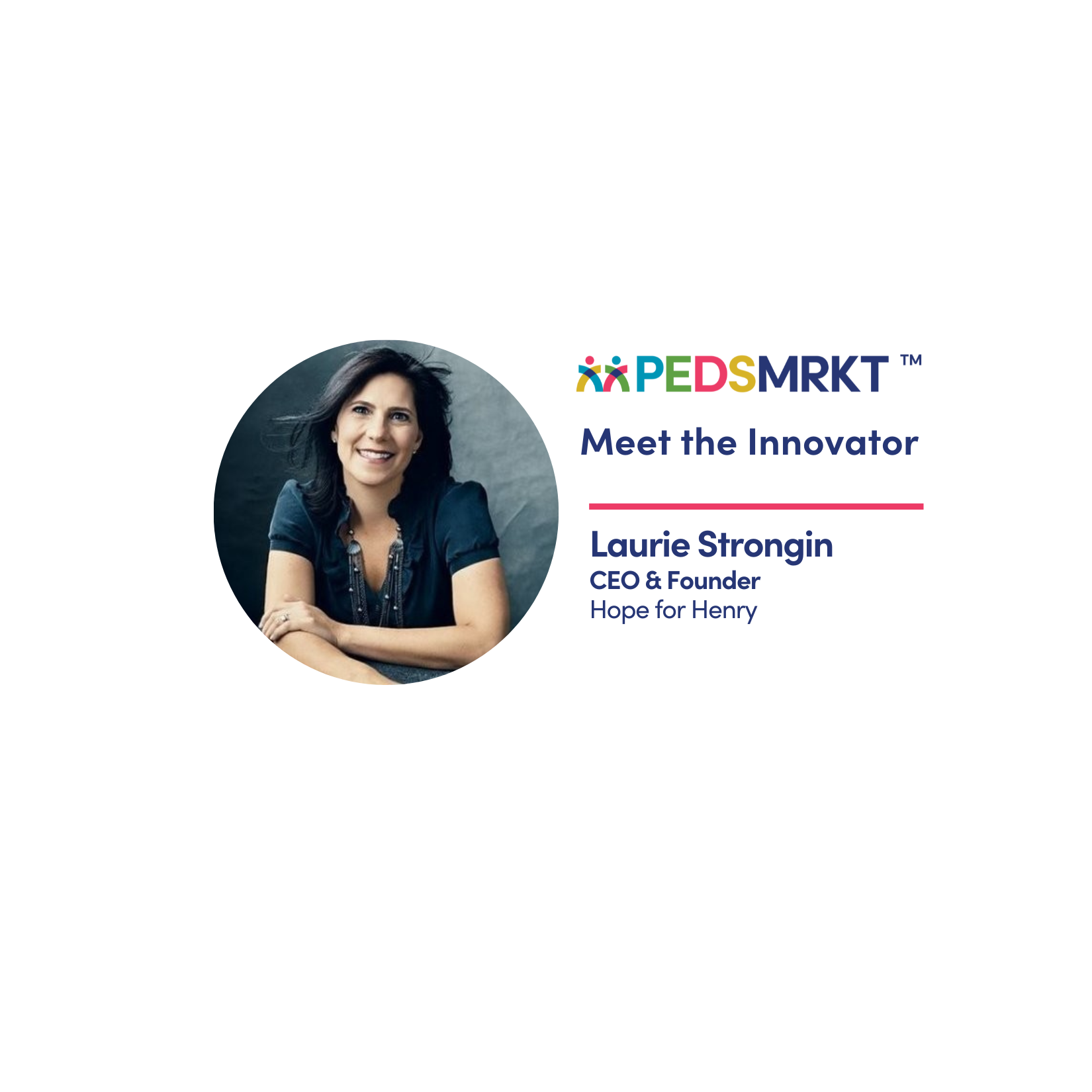Log in
Log into your PedsMrkt account to access our Community forums.
If you don't see an email, please check your Junk folder. The email will be sent from support@pedsmrkt.com
Log into your PedsMrkt account to access our Community forums.
If you don't see an email, please check your Junk folder. The email will be sent from support@pedsmrkt.com

Innovator: Laurie Strongin
Role: CEO & Founder of Hope for Henry
What problem does your innovation address?
Hope for Henry addresses the distress faced by hospitalized children during medical interventions. My family spent hundreds of days in hospitals across the country trying to save my son, Henry. During this time, high-quality medical care treated Henry the Patient, but I saw that the needs of Henry the Kid went unmet. Just like Henry, nearly 30% of hospitalized children experience severe psychological distress which can disrupt care delivery and lead to procedural delays, missed medications, and increased costs. And the current toolkit for helping children endure medical treatments, including lollipops, colorful bandages, VR goggles, and physical restraints, falls short of addressing the underlying issues. These interventions lack the educational component needed to empower patients and caregivers.
In 2003, I founded Hope for Henry to honor Henry, who died at age seven, and to address the need for better clinical interventions to help kids do all the difficult things they need to do to heal.
Describe your innovation
Hope for Henry’s Super Rewards for Super Kids program leverages the power of behavioral economics combining education, coping, and rewards to help hospitalized kids confront the challenges of serious illness, adhere to their medical plans, and thrive. It can be difficult for children to make the connection between doing difficult procedures, feeling better, and healing. Associating these actions with a physical reward like a toy has proven to be a powerful incentive. By “gamifying” the most challenging parts of medical procedures, Super Rewards brings healing and happiness to young patients nationwide. Through engaging gameboards, rewards, superhero imagery, and child appropriate language this program transforms daunting medical experiences into manageable steps. Patients, with support from their medical team, map out each step of the procedure, fostering understanding and coping skills. Once patients complete their procedure, they select a reward to acknowledge their success, connecting the intervention with a positive incentive to associate with healing.
What impact has your innovation had?
Analysis of data from more than 9,500 program beneficiaries reveals the following:
Super Rewards leads to critical medical procedures happening more quickly and seamlessly, with fewer risks and lower costs. Super Rewards for Super Kids' efficacy drives demand from hospitals and clinics nationwide as they strive to improve patient care.
What barriers did you have to overcome to make this impact?
To achieve impact, we had to overcome several barriers.
The sheer number of community groups approaching hospitals with program offerings posed a challenge in distinguishing our program from others. Our impressive impact data, paired with third-party validation from leading doctors and frontline healthcare providers who witness our impact daily, reinforces our credibility and sets us apart.
Additionally, we encountered resistance due to a prevailing "business as usual" mentality among frontline staff. Some hesitated towards innovation, viewing our program as something unfamiliar or akin to bribery. However, we clarify that our approach has a scientific underpinning. It utilizes teaching tools (the gameboards), coping techniques (engaging children in their care and providing choices), and rewards as nudges or incentives to promote adherence and improve the overall experience.
Finally, in the beginning, some institutions hesitated to be early adopters, preferring to wait until others had tried and validated our program. Our perseverance has paid off, as evidenced by the growing number of hospital partners (we grew from 31 partners in 2023 to 43 today).
As predicted, once the initial barriers were overcome, more institutions embraced our program, leading to widespread adoption and impact. When faced with daunting obstacles like bureaucracy, indifference, or financial constraints in pioneering pediatric healthcare, remember that every breakthrough, every healed child, is a universe of possibilities for their family. Your efforts don't just impact one life; they have the power to transform entire worlds.
How does collaboration help you make this impact?
Collaboration is key to Hope for Henry’s success, with partnerships extending throughout the toy industry including The Toy Foundation, Mattel, and Paramount to stock the Super Rewards bins at partner children’s hospitals. Our Child Life Team of Innovators, comprised of child life specialists at leading children’s hospitals, collaborate on developing new Hope for Henry programming, share advice on maximizing the use of Super Rewards throughout their facilities, and co-present at conferences. This expertise-sharing effort ensures that the field as a whole benefits. Collaboration helps us work towards our goal of serving
100,000 patients annually at 100 hospitals in the next three years.
How can I bring Super Rewards for Super Kids to my hospital/practice?
To learn more about how to bring Super Rewards to your patients, please contact Kelly.beck@hopeforhenry.org.